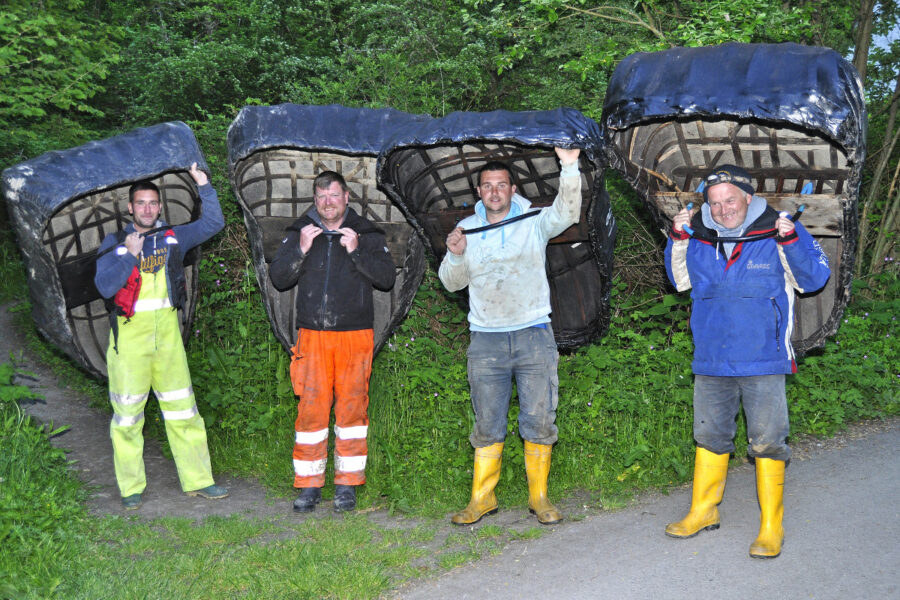SILVER LINING? – FOR TRADITIONAL WELSH CORACLE FISHERY
The historic and traditional coracle fishery for salmon and sea trout (sewin) on the river Teifi in West Wales is holding on. John Worrall reports.
Len Walters works a mixed fishery out of Cardigan – potting, netting and scalloping – but the bit he loves best is in the summer, when he fishes for salmon and sea trout from a coracle on the tidal stretch of the river Teifi.
Coracles work in pairs with a net between them, and each licence covers a pair – the licensee and the ‘endorsee’. There are 12 licences on the four-mile tidal stretch between Cardigan and Llechryd bridges (and 10 more on the Tywi in Carmarthenshire), and the Teifi also has three seine licences for the lowest stretch of the river, below Cardigan. All of them fish only on weekdays, and sea trout – or sewin as they are known in that part of the world – have become the main event. The coracle and seine net fisheries on the Tywi and Teifi account for about 95% of netted sewin in Wales.

Len Walters and the coracle pound.
“For now, our season runs from the beginning of April to the end of August,” said Len. “And we only fish neap tides, because springs move too quickly for this fishing. But until 1 June we release all salmon, even though our spring run of salmon has increased.
“We get the biggest sewin in the early part of the season; my best is 18½lb, but one of the boys had one of 19½lb last year. But 9-10lb is a good fish and, fresh in from the sea in prime condition, they’re like bars of silver. We have a 4in statutory minimum mesh, which lets through anything up to 2lb, but we’ll sometimes use a bigger size in April and May, because if big fish bump the smaller mesh, they can sometimes react and get away before we can hold them. But by mid-summer, it’s mainly smaller fish running.
“For salmon, August used to be the main month, but last year, all the Teifi coracles volunteered to release all salmon throughout the season, in an attempt to address the problem that Natural Resources Wales (NRW) says we have with the stock. But it looks like the season is now going to be shortened anyway next year, cutting out April and August.”

Construction: willow laths, woven hazel plinth, tarred calico hull, transverse seat, and hi-tech electric cable carrying strap. Most fishermen make their own.
That’s also proposed for five other rivers, including the Tywi and Taf, which hitherto have opened on 1 March. All Welsh sewin and salmon net fisheries would then open and close at the same time.
It’s an interesting fish, the sewin. It’s a brown trout, Salmo trutta, which spends part of its life at sea – the so-called anadromous lifestyle, matching that of the salmon. By no means all brown trout do that – many spend their entire lives in the rivers – but some, driven by genetic factors and, probably, lack of food, go through physiological changes to deal with salt water, turning silver with faint black spots. Then, at any stage from one-year-old, six-inch smolts to full adults, they head to sea for a year or two, returning to their natal rivers to spawn.
At sea, they eat fish, small crabs, shrimps and prawns, which give them their prized pink-red flesh, and they nearly always grow bigger than river-resident trout, averaging about 60cm, but sometimes up to twice that. Sewin are predominantly female, and bigger fish produce more eggs, at an average of 800 per pound of weight.

The late Ronnie Davies was a noted Teifi coracle maker – pictured here on 22 April, 1987, in his shed…
They re-enter the river from April onwards, although the greatest number arrive in summer and early autumn, quickly re-adopting brown trout colouration, and moving mainly at night. They don’t spawn until autumn or winter, and then they return to sea.
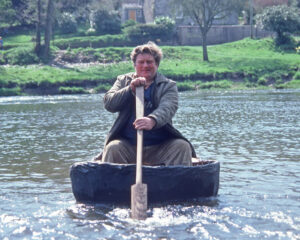
… and showing how to paddle.
Coracle netters have utilised that pattern for many generations, although coracles themselves go back a lot further, the basic design – essentially a shell in which one person can float – having developed independently in various parts of the world. The West Wales model, with slight variations from river to river, comprises a light frame of split and shaved willow stems, with a woven hazel rim, or ‘plinth’. The whole thing is covered, these days, in tarred and pitched calico.
The Teifi model has one end squared and the other rounded, with a bench seat which provides transverse stiffening, but crucially, it is light enough for a man to carry on his back, using a strap threaded through the seat, which fits over the shoulders. Historically, the straps were also of woven hazel, but in the 20th century, the Teifi model went hi-tech, in that respect at least, by adopting electric cable.
Stability is not a strong point – a coracle has been compared to a big washing-up bowl”
Stability is not a strong point – a coracle has been compared to a big washing-up bowl – and getting in and out without capsizing is the first trick. The second is paddling – not rowing – which involves using a single paddle, worked side to side in the water, and twisted to pull the coracle forward.
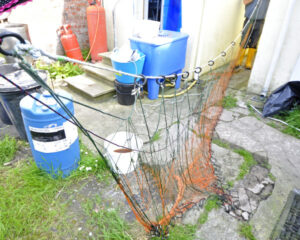
The net has the (orange) 4in mesh, and a larger mesh screen which helps to entangle the fish.
There have been notable coracle builders on this river, including Ronnie Davies and Bernard Thomas – the latter, in 1974, paddled one across the English Channel – but many fishermen, including Len and his son Aaron, make their own.
“The hardest part is collecting materials,” says Len. “You need nice straight willow stems, no more than 1½in thick, which you split with a draw knife and then shave as thin as you can – weight is crucial, because you’re carrying it around. And likewise with the hazel – you want thin, round lengths for weaving the plinth. Frames can last 10 or 15 years, but they need re-covering every year.”
The net, historically of hemp, but these days nylon, comprises two parts – the rear bag, almost a trawl, with the minimum 4in mesh, and a front screen of much larger mesh, through which fish can easily pass.
Both are suspended on rings from the top rope, while the bottom edges are held close to the riverbed by a leaded bottom rope, although for ‘rope’, in both cases, read thick cord, because the net also needs to be light.
The whole set-up, perhaps 30ft wide, is towed slowly downstream between the coracles, with each end held in one hand by a fisherman who is using the other to gently paddle the large washing-up bowl, all of that in pitch darkness – which is when the fishing is done, because the fish will otherwise see the net. (And Len stores his net in a tub of cold tea between trips to stain it, for further camouflage.)
“With the net bagged out behind, the coracles are working about two-thirds of the net-length apart, but you’ve got to be able to feel the leaded bottom rope bouncing over the riverbed stones, because if you can’t, it means there’s room for the fish to pass underneath,” says Len. “Then on each side of the net, you’ve got a length of rope, attached to a ring on the end of the top rope, with a tape marker every fathom which you can feel.
“And you let out, and haul in, according to water depth, as you go along. Sometimes, in the shallow bits, you might actually have that ring in your hand, holding the net up so that fish don’t jump over it. In the deeper parts, you’ll have maybe three fathoms out. If you’ve got too much out over a shallow stretch, the net will just snag or lie flat; if you haven’t got enough, there will be room for fish to go past. But this is all by feel, because you can’t see anything.”
It’s a delicate business, each coracle maintaining enough momentum downstream for the net to stay open, but when a fish hits, one fisherman will feel it more than the other, because it’s closer to that end, and will then simply say ‘yes’.
Then the other fisherman will quickly let out rope, allowing both the bag net and the large mesh screen to crumple and hopefully entangle the fish; the head torches come on and the coracles come quickly together to increase the entanglement, before moving to the bank for the fish to be dispatched and extricated.
They then move back out, reshoot and carry on. At the end of their reach they go ashore, put the coracles on their backs, walk back to where they started, and do it again.
Fishing News was invited to see all this, and so it was that in the last of the daylight on a late May evening, down a wooded track two miles above Cardigan, there was a rendezvous with four coracle men: Dan Rogers, whose family have been coracle licence holders for over 100 years, and Tony Priest, together with Len and Aaron Walters.
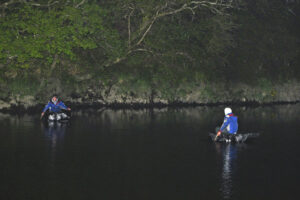
Len and Aaron, on the far side of the river
Aaron also holds one of the seine licences for the estuary fishery, but they hadn’t started that yet.
“It sounds silly,” says Len, “but although fish are coming up, they don’t tend to be caught down there on the sand at the beginning of the season, even though we’re catching them up here. The spring fish tend to favour certain parts of the river, and don’t hang about at the river mouth. So the coracles upriver do better in April, whereas the seine does better at the back end of the season.”
Fishing News had already seen the coracles in daylight, tucked away in bushes off the track, upside down on stands in tree shade, to keep the sun off the tarred hulls. But now they were quickly raised on backs and a purposeful posse – four coracles and a scribbler – hurried in single file, and by the light of head torches, along a precipitous, undulating path through thick woodland on the steep southern escarpment of the Teifi gorge – think Deliverance meets Under Milk Wood.
An earlier recce had identified a few places where breaks in the riverside trees might allow photographs, but first there was the launch.
Twenty minutes, and half a mile upstream, saw the party descending to a place where a short trench had been let in off the river into a low section of soft bank, and where one trick of the trade immediately became apparent. The trench was coracle-width and, after a bit of re-excavation – a tidal river tends to drop silt and mud – each coracle was in turn slotted in and then, loosely clasped by the trench sides, boarded with minimised risk of capsize. The pairs would set off a few minutes apart.
With the first pair on the water, Fishing News headed quickly back downstream, along the path, trying to get to a vantage point before they came past – but the first problem of photographing anything in pitch blackness then became apparent.
Black hulls moving down a dark river between thick trees, with no ambient light, are impossible to spot, and yet shining a torch might spook the naturally skittish sewin. And although the camera flash would just about span the 40-yard river width, its infrared autofocus wasn’t picking up anything. If the camera hadn’t focused, it wouldn’t fire – and manual focusing was difficult when it was impossible to see the camera, let alone the subject.
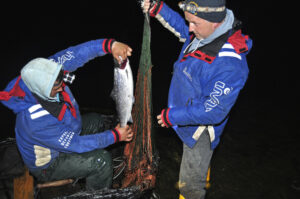
Not a bad start…
Fortuitously, Len and Aaron – for they were first – got a hit close by, which brought the head torches on and gave just enough light for the autofocus to latch onto, as the coracles came together and moved to the bank, where the fish was extricated and a blue tag attached through the mouth and gills. Carcass tagging and logbooks were introduced in 2009, since when all netted salmon and sea trout have been required to have a tag affixed immediately after capture.
NRW issues these individually identifiable tags free of charge, and because it is illegal to be in possession of untagged fish, they provide a record of numbers being caught.
But that was the most successful photographic sequence. Thereafter, on the second run, Fishing News stood for half an hour in total darkness and silence, ears straining to pick up the slightest sound of approaching paddles. It was only an eventual speculative flash shot in the dark that captured Dan and Tony going slowly past.
Despite the flash – or perhaps because of it – they almost immediately got a hit, which had Fishing News scrambling back up to the path, rushing along for 50 yards through the trees to catch up with them, and then crashing back down to the water’s edge to grab a photograph, just after they had reached the bank and extracted the fish.
But by then, it was pushing 1am, and although they would go on through the night, your correspondent felt that he wasn’t going to achieve much more. After photographing them with the catches so far – four sewin – he left them to it.
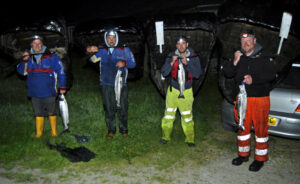
Didn’t they all do well? And for them, the night was still young.
In the morning, at the farmers’ market in Len’s village of St Dogmaels, next to Cardigan, his wife Mandy had three sewin on the stall where she also sells their lobsters and crabs. You won’t get many products with fewer food miles.
Nevertheless, this is a fishery fighting to hold position. Of the 33 recognised Welsh sewin rivers, the Teifi is pre-eminent, but it is also among the 21 deemed ‘at risk’ or ‘probably at risk’.
There has been much foreboding about the state of salmon and sewin stocks generally, and their fortunes are closely interwoven, although the problems of salmon are considerably more serious. Stocks on 20 of the 23 principal rivers are reckoned to be failing. Sewin are distributed more widely, and are generally more abundant than salmon in Welsh rivers.
But recognition of those problems, perceived or actual, from way back, saw the number of annual salmon and sea trout net licences decrease by 60% between 1989 and 2006, although it has stabilised in the low 50s since then.
There are certainly physical threats to the stocks of both species, starting with agricultural pollution from general run-off and specific events. The number of incidents caused annually by dairy and beef farms across Wales ranged from 85 to 120 between 2010 and 2016, and on the Teifi, in December 2016, a slurry leak near the top of the catchment – where, and when, the fish were spawning – reportedly killed all salmon and trout in a two-mile stretch. What further damage was done below that isn’t known, but that year’s cohort could have been substantially depleted.
Ironically, fishermen say that the previous year had seen the best run of sewin – in numbers caught – for a decade and a half.
Then there is climate change. Sewin and salmon are cold water fish, with their eggs laid mainly in December and January, when the water is cold and oxygenated. But wet winters bring greater flows, which scour riverbeds, disturb nests, and damage eggs and juveniles.
NRW says that following the exceptionally wet and warm winter of 2015-2016, there was a reduction in the numbers of fry in most rivers, including near-absence in some, with implications for future adult salmon and sewin runs, particularly in 2019-2020.
And then there are predators. “Seals like we’ve never seen before,” says Len. “Thirty years ago, if you saw a seal, you stopped and looked, because they were that rare. Now there must be 1,000 within a mile of the river mouth. And dolphins, more than ever, and otters, and cormorants, which take the parr.”
You could throw in acidification from conifer plantations in the catchment and, for that matter, by-catch in pelagic trawls – although the latter isn’t considered significant. All of this, set against environmental designations, inevitably induces tighter management.
Six rivers, including the Teifi, are Special Areas of Conservation (SACs) under the EU Habitats Directive, with salmon as a designated qualifying species. While sewin is not designated, the obligations on habitat apply holistically, which then brings the dreaded precautionary principle into play.

In the morning, at the village farmers’ market, Len’s wife Mandy had sewin for sale.
And yet, on the other side of the coin, this fishery is firmly part of local heritage. Last year, West Wales Coracle Caught Sewin was awarded Protected Geographical Indication (PGI) status by the European Commission, which means that fish marketed as such have to be the real thing. It joins nearly a dozen other products, like Welsh lamb, Conwy mussels and West Wales Coracle Caught Salmon, with such protection.
That doesn’t guarantee that it won’t eventually be reduced to curiosity status, of course, and there was talk in 2009/2011 of introducing a ‘heritage licence’ as a separate category. But netters made it clear that they are commercial fishermen and not museum demonstration pieces, although they were in favour of carcass tagging, and also of information signage to explain the industry to the public, something which was then put in place at Cilgerran just upstream, where eight of the Teifi’s coracle pairs operate.
But the general drift is still towards statutory measures. Despite the coracles’ voluntary catch-and-release (C&R) of salmon last year, NRW has now proposed statutory controls on both netters and anglers.
Voluntary C&R had been growing among anglers for a while, but not all took to it and the trend had stalled. In 2016, on some ‘at risk’ rivers, just over half of anglers returned all salmon, but nearly a quarter were killing everything they caught. Anyway, a voluntary system inevitably bred suspicions among those complying that others weren’t.
Between 2015 and 2017, NRW consulted with all and sundry, having been monitoring salmon and sewin through electro-fishing and fish traps since 1986. While acknowledging that stock assessment and prediction is not an exact science, NRW is sufficiently certain of the extent of stock problems to conclude that statutory measures are indeed required. (An ICES working group is also now due to produce a report in 2019, although in that case, it is to be hoped that it comes with a stated methodology which is more persuasive than that on bass.)
So, in February of this year, NRW put proposals to the Welsh government for ratification to take effect in the 2019 net and rod seasons.
They include full statutory C&R on salmon for anglers and netters, while on sewin, there will be statutory C&R for anglers prior to 1 May on targeted rivers, and also a maximum retention length of 60cm, to protect those large female fish with the most eggs. Anglers will not be allowed to use worm baits, or to use barbed hooks on either species, the latter measure to improve C&R survival rates.
Most importantly for netters, the season will be shortened to three months, from 1 May to 31 July, a measure aimed at reducing the take of those big, early-season sewin and late-summer salmon.
That shortening isn’t good, particularly because netters presently pay a few hundred quid a year for a five-month season on salmon and sewin, but now stand to lose salmon, and 40% of the season, without any sign so far of a lower licence fee.
But at least the fishery remains open, with the number of licensed netters maintained. And the PGI status for sewin, which further enshrines it – coracles, fish and all – in the national consciousness, could be a silver lining, which gives some hope of keeping the heritage alive.
For, as Len says, “It would be a shame to lose it, because then the only place you’d see coracles is in a museum. They are made by the boys who are fishing, and they are made to fish. If you take the fishing away, they will disappear.”

